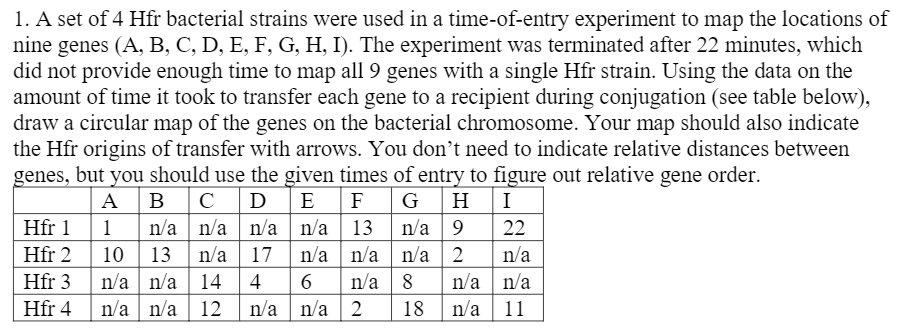1. A set of 4 Hfr bacterial strains were used in a time-of-entry experiment to map the locations of nine genes (A, B, C, D, E, F, G, H, I). The experiment was terminated after 22 minutes, which did not provide enough time to map all 9 genes with a single Hfr strain. Using the data on the amount of time it took to transfer each gene to a recipient during conjugation (see table below), draw a circular map of the genes on the bacterial chromosome. Your map should also indicate the Hfr origins of transfer with arrows. You don't need to indicate relative distances between genes, but you should use the given times of entry to figure out relative gene order. |G |H n/a 9 | BC D E F n/a n/a A I Hfr 1 n/a n/a 13 1 10| 13 n/a n/a | n/a | 14 n/a n/a 12 22 n/a n/a n/a n/a 2 | 8 18 n/a | 11 Hfr 2 17 n/a Hfr 3 4 6 n/a n/a Hfr 4 n/a | n/a | 2
Bacterial Genomics
The study of the morphological, physiological, and evolutionary aspects of the bacterial genome is referred to as bacterial genomics. This subdisciplinary field aids in understanding how genes are assembled into genomes. Further, bacterial or microbial genomics has helped researchers in understanding the pathogenicity of bacteria and other microbes.
Transformation Experiment in Bacteria
In the discovery of genetic material, the experiment conducted by Frederick Griffith on Streptococcus pneumonia proved to be a stepping stone.
Plasmids and Vectors
The DNA molecule that exists in a circular shape and is smaller in size which is capable of its replication is called Plasmids. In other words, it is called extra-chromosomal plasmid DNA. Vectors are the molecule which is capable of carrying genetic material which can be transferred into another cell and further carry out replication and expression. Plasmids can act as vectors.

Trending now
This is a popular solution!
Step by step
Solved in 4 steps with 1 images


